-
RESEARCH01-01-2018
Family health strategy: relevance to the functional capacity of older people
Revista Brasileira de Enfermagem. 2018;71:740-746
Abstract
RESEARCHFamily health strategy: relevance to the functional capacity of older people
Revista Brasileira de Enfermagem. 2018;71:740-746
DOI 10.1590/0034-7167-2017-0078
Views0See moreABSTRACT
Objective:
to identify the functional capacity of older people based on their performance on basic activities of daily living.
Method:
a cross-sectional study, carried out through the record of the Family Health teams working in the urban area of a city in northern Minas Gerais, in 2015. To assess the functional capacity of 373 older people, the Katz Scale was applied, which includes dimensions on the performance of daily living activities. The interviews took place in the participants’ households.
Results:
of the total participants, 6.9% had some degree of dependence. Those aged over 80 years old and were living without a partner had about three times more chances of presenting higher levels of functional dependence.
Conclusion:
most older people enrolled in a Family Health Strategy had their functional capacity preserved.
-
RESEARCH01-01-2018
Assessment of ulceration risk in diabetic individuals
Revista Brasileira de Enfermagem. 2018;71:733-739
Abstract
RESEARCHAssessment of ulceration risk in diabetic individuals
Revista Brasileira de Enfermagem. 2018;71:733-739
DOI 10.1590/0034-7167-2017-0337
Views0See moreABSTRACT
Objective:
To identify the risk factors for foot ulceration through the tracing of diabetic peripheral neuropathy and peripheral arterial disease in individuals with type I and II diabetes, who were assisted in reference centers of the Federal District, Brazil.
Method:
a cross-sectional and analytical study, with the assessment of 117 individuals in outpatient clinics of the Federal District. Continuous variables were compared through Mann-Whitney test, and categorized variables, through Chi-square test for univariate analysis and Logistics regression test for multivariate analysis.
Results:
painful diabetic peripheral neuropathy was present in 37 (75.5%) of the individuals with neuropathy. Deformities and loss of protective plant sensibility were related to neuropathy (p=0.014 and p=0.001, respectively). Of the 40 (34.2%) individuals in the sample who presented peripheral arterial disease, 26 (65%) presented calcification risk.
Conclusion:
signs of painful peripheral polyneuropathy, peripheral arterial disease, deformities, loss of protective plantar sensibility, and dry skin were identified as risk factors for ulceration.
-
RESEARCH01-01-2018
Aging and quality of life of elderly people in rural areas
Revista Brasileira de Enfermagem. 2018;71:724-732
Abstract
RESEARCHAging and quality of life of elderly people in rural areas
Revista Brasileira de Enfermagem. 2018;71:724-732
DOI 10.1590/0034-7167-2017-0149
Views0See moreABSTRACT
Objective:
To evaluate the quality of life and health of elderly in rural areas of Minas Gerais State’s center-west.
Method:
Cross-sectional study, in four municipalities of Minas Gerais State, by interviewing elderly people. Associations between socio-demographic and quality of life variables were tested, separated into “satisfactory”/“unsatisfactory” with values from the median of positive answers. It was used the chi-square test, Fisher’s test and regression.
Results:
182 elderly answered the questions and showed a relation with the “satisfactory” quality of life – bivariate (p < 0.05): age by 69 years (61.6%), married (61.7%), living by 54 years in rural areas (68%), with no financial support (59.5%), living with someone else (61%), non-smoker (60%), presenting good health (76.7%), satisfied with life (69.6%); regression: not having financial support, living with someone else and not smoking.
Conclusion:
Elderly people in rural areas present good quality of life/health in the cognitive aspect, access to services, goods, habits, but awareness must be constant due to their weakness.
-
01-01-2018
Population aging and the Nursing commitment
Revista Brasileira de Enfermagem. 2018;71:722-723
Abstract
Population aging and the Nursing commitment
Revista Brasileira de Enfermagem. 2018;71:722-723
DOI 10.1590/0034-7167-201871Sup201
Views0Since the end of the 1970s Brazil has imposed administrative and political tools that define who are elderly. The National Policy for Senior Citizens (NPSC) states that elderly people are the ones who are 60 years old and above, according to the Law 8,842 on January 4th, 1994 and governed by the Decree 1948 on […]See more -
01-01-2018
O envelhecimento populacional e o compromisso da enfermagem
Revista Brasileira de Enfermagem. 2018;71:722-723
Abstract
O envelhecimento populacional e o compromisso da enfermagem
Revista Brasileira de Enfermagem. 2018;71:722-723
DOI 10.1590/0034-7167-201871Sup201
Views0O Brasil, desde o final da década de 90, instituiu instrumentos administrativos e políticos que definem claramente quem é idoso. A política nacional do idoso (PNI) define idoso como sendo uma pessoa com 60 anos ou mais por meio da Lei nº8. 842, de 4 de janeiro de 1994 e regulamentada pelo Decreto nº 1948 […]See more -
REFLECTION01-01-2018
Advanced practice nursing: a possibility for Primary Health Care?
Revista Brasileira de Enfermagem. 2018;71:716-721
Abstract
REFLECTIONAdvanced practice nursing: a possibility for Primary Health Care?
Revista Brasileira de Enfermagem. 2018;71:716-721
DOI 10.1590/0034-7167-2017-0672
Views0See moreABSTRACT
Objective:
Reflect on the role of advanced practice nursing (APN) in the context of Brazilian primary health care.
Method:
analysis of the main scientific productions and of the discussion on the implementation of APN.
Results:
there are favorable areas for the work of APN in primary health care, especially in the family health strategy. Professional master’s degree and nurse residency programs constitute powerful training spaces. As a challenge, standardized definition of the roles of advanced practice nurses and of minimum training for work are necessary.
Final considerations:
researches that contribute to understanding the perspectives, facilitators, and barriers for APN are necessary, as well as determining the population’s health needs and expectations concerning the role of these professionals.
-
REFLECTION01-01-2018
Nursing in Collective Health: reinterpretation of objective reality by the praxis action
Revista Brasileira de Enfermagem. 2018;71:710-715
Abstract
REFLECTIONNursing in Collective Health: reinterpretation of objective reality by the praxis action
Revista Brasileira de Enfermagem. 2018;71:710-715
DOI 10.1590/0034-7167-2017-0677
Views0See moreABSTRACT
Objective:
To discuss the phase of reinterpretation of objective reality of the Theory of Praxis Intervention of Nursing in Collective Health (Tipesc), in search of the praxis that it promotes.
Method:
Analysis of interventions in projects that are based on Tipesc and its results, since the 1990s.
Results:
Developed and implemented projects show that praxis is the way to achieve the aimed changes.
Conclusion:
We concluded that Tipesc is currently the explanatory and interventional theory, since it is grounded on its theoretical bases, which arise from philosophical bases of dialectical and historical materialism.
-
REFLECTION01-01-2018
The complexity of the work of nurses in Primary Health Care
Revista Brasileira de Enfermagem. 2018;71:704-709
Abstract
REFLECTIONThe complexity of the work of nurses in Primary Health Care
Revista Brasileira de Enfermagem. 2018;71:704-709
DOI 10.1590/0034-7167-2017-0471
Views0See moreABSTRACT
Objective:
to promote thinking on the work of nurses in Primary Health Care (PHC) and the necessary aspects for the (re)construction of this professional practice, reinforcing its role in the care of individuals, families and communities.
Method:
to apply the questions raised in the process of organizing a book, the literature and the PHS work experience of the authors.
Results:
Conflicts, dilemmas and relevant aspects of the practice of nurses in PHC are presented, contributing to critical thinking about the context of work and the need to articulate the category in the construction of its workspace.
Final considerations:
the practice of nurses in PHC is broad and a process of qualification field, whether performing in clinical, educational or managerial activities, and nurses need to be familiar with these contents in their daily work, seeking to articulate their class entities for the development of this specialty.
-
EXPERIENCE REPORT01-01-2018
Clinical and epidemiological teaching of dengue through simulated practice
Revista Brasileira de Enfermagem. 2018;71(2):451-456
Abstract
EXPERIENCE REPORTClinical and epidemiological teaching of dengue through simulated practice
Revista Brasileira de Enfermagem. 2018;71(2):451-456
DOI 10.1590/0034-7167-2016-0503
Views2See moreABSTRACT
Objective:
to describe the experience of clinical teaching on dengue and the practice of epidemiological surveillance using problematization methodology.
Method:
report of experience on educational activity with undergraduate nursing students, held in March 2016, at a public university in the city of São Paulo, conceived in four stages: dialogic lecture, active search of Aedes aegypti, case study and simulation of nursing consultation to individuals with dengue.
Results:
The activity allowed to retrieve previous knowledge about the disease, respond to exercises that addressed different clinical situations and epidemiological surveillance, including in situ evaluation of possible mosquito outbreaks, and discuss the need to expand prevention and health of the individual and the community, the impact of the media in the dissemination of cases and the coping difficulties experienced in the different levels of attention.
Conclusion:
the methodology adopted enabled qualified training of students to cope with dengue.

-
ORIGINAL ARTICLE07-18-2022
Beliefs, knowledge, actions of nursing techniques in breastfeeding in pain management in immunization
Revista Brasileira de Enfermagem. 2022;75(6):e20210546
Abstract
ORIGINAL ARTICLEBeliefs, knowledge, actions of nursing techniques in breastfeeding in pain management in immunization
Revista Brasileira de Enfermagem. 2022;75(6):e20210546
DOI 10.1590/0034-7167-2021-0546
Views1See moreABSTRACT
Objective:
Understand the beliefs, knowledge, and actions of nursing technicians on breastfeeding as a form of non-pharmacological intervention to relieve pain in newborns and infants during immunization.
Methods:
Qualitative study carried out through semi-structured interviews with nine nursing technicians from three Basic Health Units in a city in the state of São Paulo. The theoretical approach of the Belief Model and the methodological framework of Thematic Analysis supported this study.
Results:
Three themes originated: Beliefs, Knowledge, and Actions of nursing technicians.
Final considerations:
Despite knowledge about the benefits of breastfeeding as the most effective method for relieving pain in newborns and infants during vaccination, their restrictive beliefs overrode the evidence, leading them to act in ways that discourage or prevent the mother from breastfeed during vaccination. Formal training is recommended to align with current evidence-based practices.
-
REVIEW12-08-2023
Educational technologies for accident prevention due to falls in childhood: a scoping review
Revista Brasileira de Enfermagem. 2023;76:e20220807
Abstract
REVIEWEducational technologies for accident prevention due to falls in childhood: a scoping review
Revista Brasileira de Enfermagem. 2023;76:e20220807
DOI 10.1590/0034-7167-2022-0807
Views2See moreABSTRACT
Objectives:
to map evidence on educational technology use for accident prevention due to falls in childhood.
Methods:
a scoping review, carried out in October and November 2022, in the MEDLINE, Web of Science, BDENF and CINAHL databases and LILACS bibliographic index. There was no delimitation of language or time. Data were extracted and analyzed descriptively by two independent researchers. The research protocol was registered in the Open Science Framework.
Results:
twenty-six studies were selected. Booklets, pamphlets and leaflets were the most used technologies, presenting health services as the most frequent environment to develop research on fall prevention. The technologies developed were important outcomes: increased knowledge of children, family members, caregivers, health and education professionals.
Conclusions:
educational technology use makes it possible to increase knowledge, adopt safe practices and reduce falls.

-
REVIEW03-15-2024
Resources for health literacy among caregivers of prematurely born children: a scoping review
Revista Brasileira de Enfermagem. 2024;77(1):e20230062
Abstract
REVIEWResources for health literacy among caregivers of prematurely born children: a scoping review
Revista Brasileira de Enfermagem. 2024;77(1):e20230062
DOI 10.1590/0034-7167-2023-0062
Views1See moreABSTRACT
Objectives:
to map the available evidence on resources used to promote health literacy among caregivers of prematurely born children during outpatient follow-up.
Methods:
the Joanna Briggs Institute’s scope review protocol was utilized. The search encompassed six databases, incorporating studies from 2012 to 2022.
Results:
the three included publications revealed that the resources employed are: mobile applications, phone calls, individual counseling, videos, educational pamphlets, and group discussions. Implementing an education protocol during the transition home enhances scientifically grounded health promotion rates.
Conclusions:
there is limited literature addressing the health literacy of these caregivers. The nursing team plays a crucial role in health education and in developing resources applicable to these families.

-
ORIGINAL ARTICLE01-13-2024
Social representations of oncologic surgery for patients with cancer
Revista Brasileira de Enfermagem. 2024;77(6):e20230273
Abstract
ORIGINAL ARTICLESocial representations of oncologic surgery for patients with cancer
Revista Brasileira de Enfermagem. 2024;77(6):e20230273
DOI 10.1590/0034-7167-2023-0273
Views2See moreABSTRACT
Objectives:
to analyze the social representations of patients with cancer regarding oncologic surgery.
Methods:
a qualitative study based on Social Representation Theory was conducted with 126 participants between October 2021 and May 2022 in a public hospital in Rio de Janeiro. A characterization questionnaire, free evocations of the inducing term “surgery”, and semi-structured interviews with 60 participants were applied. Data were analyzed using Microsoft Excel® and IRaMuTeQ.
Results:
the central core of the representation is composed of fear, cure, hope, and removing the disease. The analysis of interviews resulted in six classes that highlight the social changes caused by treatment as well as the need for a support network to cope with the surgical process.
Final Considerations:
the representations reflect fear and hope towards the procedure and the desire to remove the disease, thus translating the cure through surgery.

-
ORIGINAL ARTICLE01-13-2024
Nurses’ perspectives on the use of telemonitoring in the management of people with diabetes and hypertension
Revista Brasileira de Enfermagem. 2024;77(6):e20230481
Abstract
ORIGINAL ARTICLENurses’ perspectives on the use of telemonitoring in the management of people with diabetes and hypertension
Revista Brasileira de Enfermagem. 2024;77(6):e20230481
DOI 10.1590/0034-7167-2023-0481
Views3See moreABSTRACT
Objectives:
to understand the perspective of nurses on the use of telemonitoring in the management of people with type 2 diabetes mellitus and arterial hypertension in primary care.
Methods:
this qualitative research involved sixteen nurses from eight municipalities in Paraná. Data were collected between November 2022 and January 2023 through inperson or remote interviews, which were audio-recorded and subjected to content analysis.
Results:
according to the nurses, telemonitoring enhances users’ knowledge about these conditions, communication and connection with the team, and productivity. However, the lack of electronic resources and equipment, high staff turnover, low user adherence, and the limited availability of professional time present significant challenges.
Final Considerations:
the effective implementation and operation of telemonitoring in the management of people with diabetes and hypertension involve both potential benefits and barriers. It is essential to have the availability of human and technological resources, managerial support, and the commitment of professionals and users.
-
ERRATUM01-13-2024
ERRATUM
Revista Brasileira de Enfermagem. 2024;77(6):e2024n6e08
Abstract
ERRATUMERRATUM
Revista Brasileira de Enfermagem. 2024;77(6):e2024n6e08
DOI 10.1590/0034-7167.20247706e08
Views2In the article “Brazilian nursing specific situation, middle and micro-range theories: a bibliometric study”, with DOI number: , published in Revista Brasileira de Enfermagem, 2024;77(4):e20230520, Chart 1:Where it read:[…]See more -
ORIGINAL ARTICLE09-29-2022
Palliative care production for health professionals in the context of home care
Revista Brasileira de Enfermagem. 2022;75(1):e20210030
Abstract
ORIGINAL ARTICLEPalliative care production for health professionals in the context of home care
Revista Brasileira de Enfermagem. 2022;75(1):e20210030
DOI 10.1590/0034-7167-2021-0030
Views1See moreABSTRACT
Objectives:
to analyze palliative care production developed by health professionals to home care patients.
Methods:
this is an exploratory study, with a qualitative approach, using the transpersonal care theoretical framework. Thirteen interviews were conducted with health professionals and 18 observations were conducted on different cases. Content analysis was performed using MAXQDA©.
Results:
actions performed: maintenance and follow-up measures to people eligible for palliative care, in acts of dialogue and “listening” to caregivers and users, conducting guidelines for the care and self-care process, performing technical procedures, delivery of materials, referrals and medical prescriptions to users.
Final Considerations:
it is perceived the need for advances in the implementation of government policies in Brazil that insert palliative care into the Health Care Network through educational, managerial and care actions that ensure human dignity, thus allowing the development of these and other palliative care interventions.
-
ORIGINAL ARTICLE09-21-2020
Transcultural theory in nursing care of women with infections
Revista Brasileira de Enfermagem. 2020;73:e20190586
Abstract
ORIGINAL ARTICLETranscultural theory in nursing care of women with infections
Revista Brasileira de Enfermagem. 2020;73:e20190586
DOI 10.1590/0034-7167-2019-0586
Views0See moreABSTRACT
Objective:
To analyze how nurses consider, in their practice of healthcare, the sociocultural context of women with sexually transmitted infections.
Method:
Qualitative research, carried out in October 2017, with ten nurses working in teams of the Estratégia de Saúde da Família (Family Health Strategy). The data were collected through semi-structured interviews, subsequently transcribed, and submitted to the organization supported by the Discourse of the Collective Subject method and analyzed according to Madeleine Leininger’s transcultural theory.
Results:
Nurses identified the sociocultural aspects of women with sexually transmitted infections and recognized the presence of influencing factors: technological, religious, economic, political, and legal, kinship and social, cultural values, and lifeways.
Final Considerations:
The study found that the provision of care by nurses in Primary Health Care is close to the sociocultural aspects of these women when considering the beliefs and values of each individual, especially regarding the life context and their care experiences.
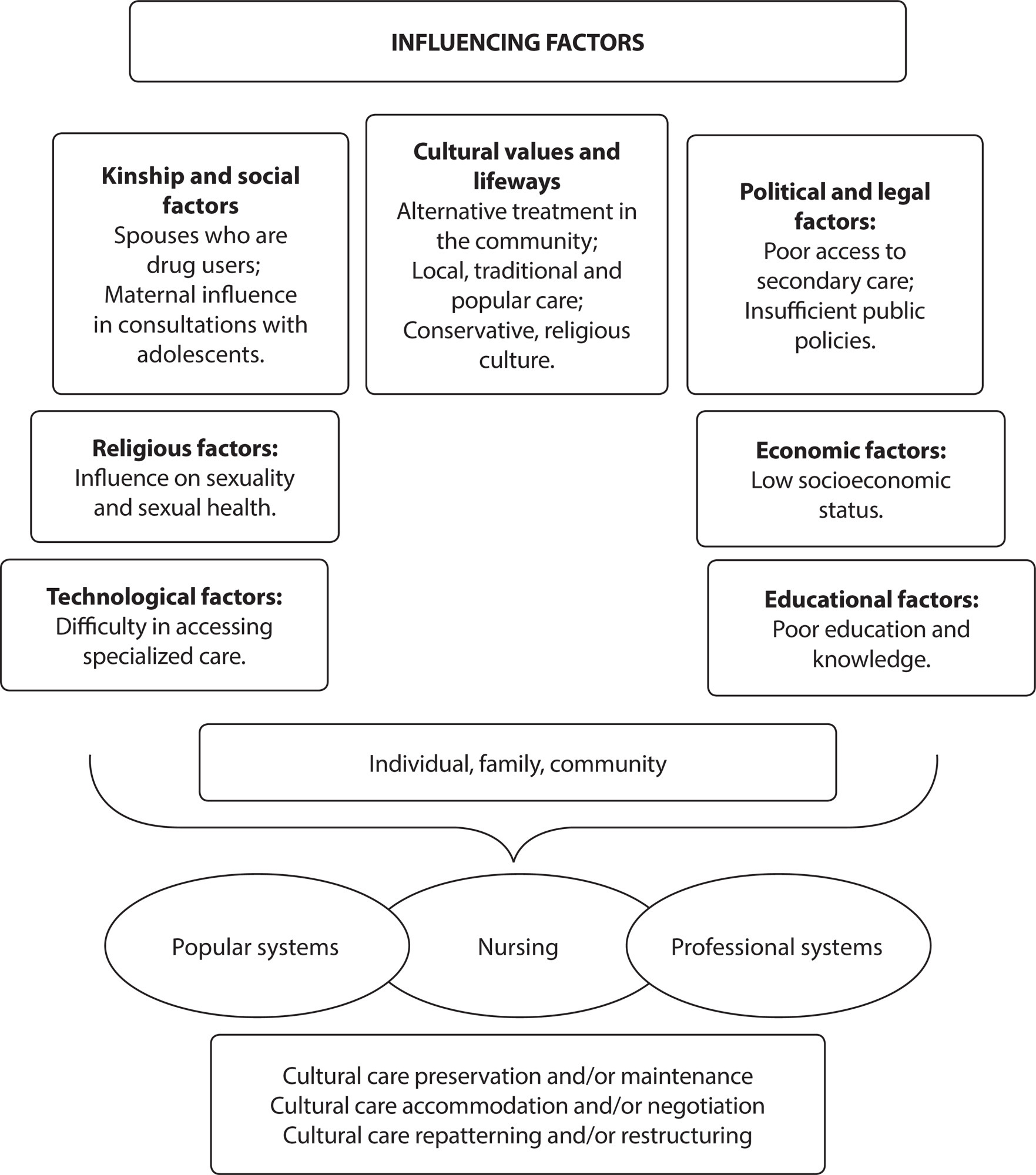
-
ORIGINAL ARTICLE11-15-2022
Reasons assigned to suicide attempts: adolescents’ perceptions
Revista Brasileira de Enfermagem. 2022;75:e20210163
Abstract
ORIGINAL ARTICLEReasons assigned to suicide attempts: adolescents’ perceptions
Revista Brasileira de Enfermagem. 2022;75:e20210163
DOI 10.1590/0034-7167-2021-0163
Views0See moreABSTRACT
Objective:
identify the reasons for attempting suicide from the perspective of adolescents.
Methods:
qualitative study conducted with ten adolescents who attempted suicide and were attending a Centro de Atenção Psicossocial Infanto-Juvenil located in a city in the south of Brazil. Semi-structured interviews were held in July 2020 using WhatsApp. Data were analyzed according to Minayo’s Content Thematic Analysis.
Results:
the adolescents’ reports listed the reasons that triggered suicide attempts, such as changes in the adolescents’ life cycle and violence, which led them to attempt suicide to solve problems.
Final considerations:
Data analysis revealed the reasons that triggered suicide attempts from the adolescents’ perspective and difficulties to cope with problems, probably explained by their lack of experience in dealing with frustrations and disappointments.
-
REFLECTION06-04-2021
Care in pediatric nursing from the perspective of emotions: from Nightingale to the present
Revista Brasileira de Enfermagem. 2021;74(4):e20200377
Abstract
REFLECTIONCare in pediatric nursing from the perspective of emotions: from Nightingale to the present
Revista Brasileira de Enfermagem. 2021;74(4):e20200377
DOI 10.1590/0034-7167-2020-0377
Views0See moreABSTRACT
Objective:
Reflect on the evolution of pediatric nursing care from the perspective of emotions, from the conceptions of Florence Nightingale to the present.
Method:
Reflective study based on theoretical and experiential aspects of emotional care in pediatric nursing.
Results:
From Nightingale, there were many definitions regarding the nursing care in an integrative and humanist logic; and with certain bond to emotional dimension. That time, nursing care was based on the religious conceptions of charity and love of our neighbor and, despite the conceptualization that shapes nursing science today, such conceptions have not ceased to be its attribute, mainly in the care of pediatric nurses.
Final considerations:
In pediatric nursing, nurture care with affection and facilitate emotions management in each interaction nurse-child-family is crucial for caring. This emotional care should evolve into a competence that recognizes the expertise and merit of professional action.
-
ORIGINAL ARTICLE04-03-2020
Analysis of the guiding rules of the nurse technician’s practice in Brazil
Revista Brasileira de Enfermagem. 2020;73(3):e20180322
Abstract
ORIGINAL ARTICLEAnalysis of the guiding rules of the nurse technician’s practice in Brazil
Revista Brasileira de Enfermagem. 2020;73(3):e20180322
DOI 10.1590/0034-7167-2018-0322
Views0INTRODUCTIONThe institutionalization of nursing as a profession is characterized by the division of labor, marked by discipline and hierarchy, with the participation of several active agents, among which we can cite the nurse, the nurse technician, the nursing assistant, and the nursing attendant. The latter, although mentioned in the legislation, has been extinct since the […]See more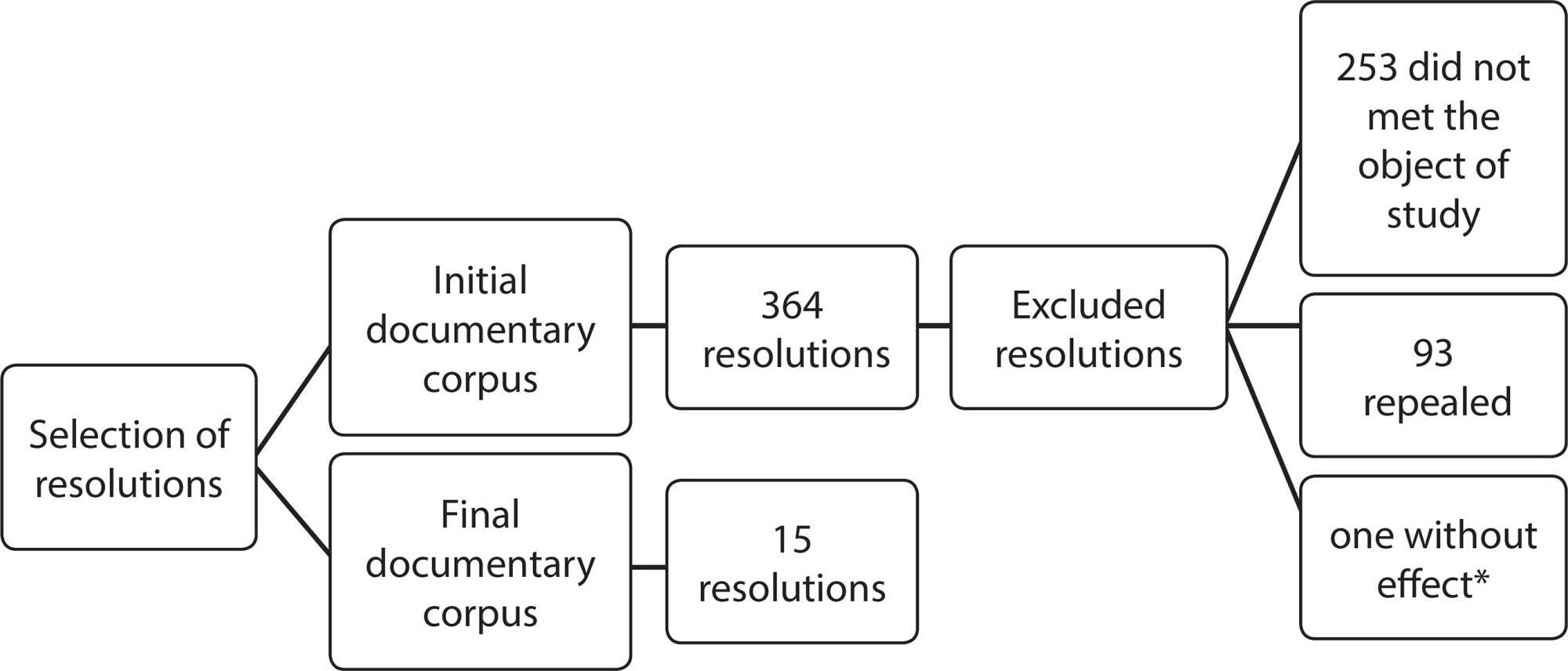
-
REVIEW09-06-2022
Biosafety measures to prevent COVID-19 in healthcare professionals: an integrative review
Revista Brasileira de Enfermagem. 2022;75(1):e20201191
Abstract
REVIEWBiosafety measures to prevent COVID-19 in healthcare professionals: an integrative review
Revista Brasileira de Enfermagem. 2022;75(1):e20201191
DOI 10.1590/0034-7167-2020-1191
Views0See moreABSTRACT
Objective:
to identify the main biosafety measures for preventing COVID-19 in healthcare professionals.
Methods:
this is an integrative literature review, with studies published between January and July 2020, on the MEDLINE/PubMed, Scopus, Embase, Web of Science, LILACS, SciELo, Wiley Online Library, Cochrane CINAHL databases. The selection of studies followed the PRISMA recommendations.
Results:
among the 2,208 publications identified, 12 studies comprised the sample, which enabled the analysis in four thematic categories: The importance of using recommendations about the use of personal protective equipment; The restructuring of new operational and clinical routines and flows in the practice of services; Monitoring professionals, especially testing; Conducting training.
Conclusions:
the phenomena involved are innumerable, covering operational management and the training of teams to deal with highly infectious pathogens and disease outbreaks.
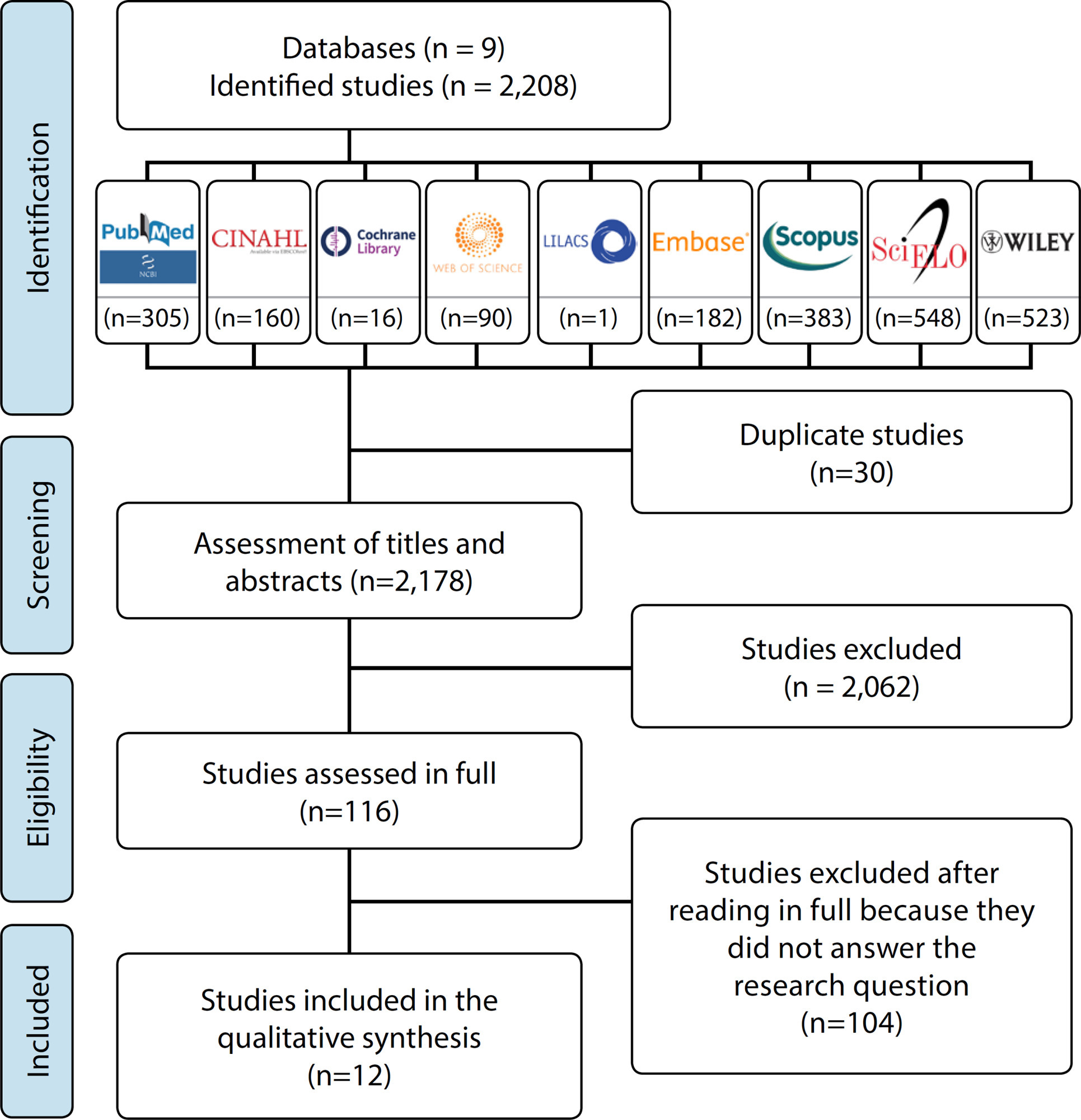
-
ORIGINAL ARTICLE09-21-2020
Organizational flow chart of home care for children with special health care needs
Revista Brasileira de Enfermagem. 2020;73:e20190310
Abstract
ORIGINAL ARTICLEOrganizational flow chart of home care for children with special health care needs
Revista Brasileira de Enfermagem. 2020;73:e20190310
DOI 10.1590/0034-7167-2019-0310
Views0See moreABSTRACT
Objective:
To develop a workflow protocol for Home Care (HC) services in the HC2 modality for children with special health care needs (CSHCN) in the state of Parana.
Method:
Quantitative, descriptive, exploratory, multiple case studies. Data was collected with professionals from the eight home care services in Parana. Data were analyzed using the Strengths, Weaknesses, Opportunities and Threats (SWOT) methodology, from which a 5W2H method of action plan was developed, resulting in a flow chart.
Results:
Considering the strategies found in Home Care services, such as planned hospital discharge, caregiver training, organized transportation and singular therapeutic project, a flow organization protocol for children with special health care needs in Home Care services was developed.
Conclusion:
The protocol developed makes it possible to organize the care provided to children with special health care needs in home care.
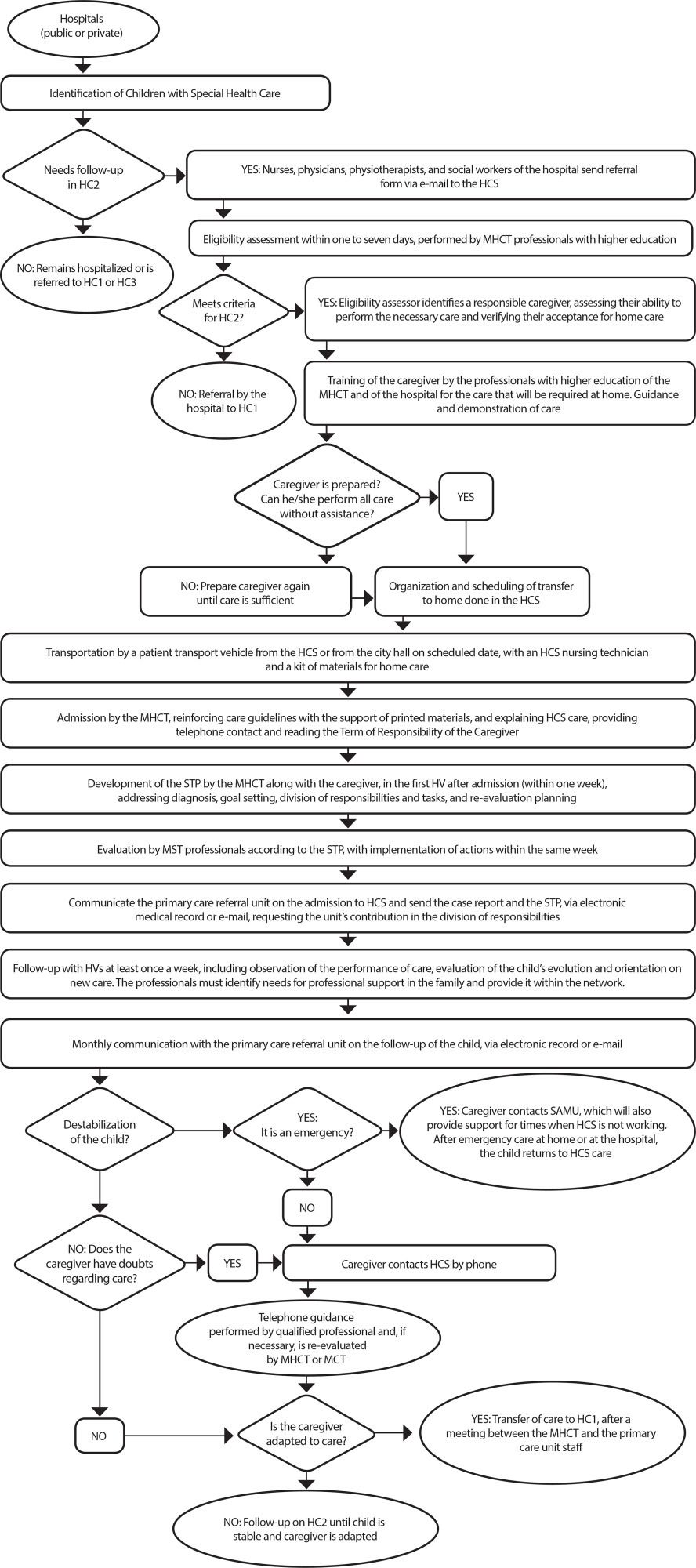
-
ORIGINAL ARTICLE02-10-2020
Relationship between quality of life, self-esteem and depression in people after kidney transplantation
Revista Brasileira de Enfermagem. 2020;73(1):e20180245
Abstract
ORIGINAL ARTICLERelationship between quality of life, self-esteem and depression in people after kidney transplantation
Revista Brasileira de Enfermagem. 2020;73(1):e20180245
DOI 10.1590/0034-7167-2018-0245
Views0See moreABSTRACT
Objective:
to assess the relationship between health-related quality of life with depression and self-esteem of people after kidney transplantation.
Method:
a cross-sectional study of 47 outpatients from October 2016 to February 2017. The following tools were applied: The Medical Outcomes Study 36-Item Short-Form Health Survey, Beck Depression Inventory and Rosenberg Self-Esteem Scale. Descriptive statistics and Spearman correlation were used.
Results:
women had lower scores for health-related quality of life. Young adults, people with up to one and a half years of transplantation and those who had dialysis for more than one year had higher scores.
Conclusion:
the health-related quality of life of people with chronic kidney disease after transplantation ranged from good to excellent. The presence of depression was not identified. The relationship of data indicates that the higher the quality of life, the better the self-esteem assessment.
-
03-19-2021
Life satisfaction and health self-assessment of older adults assisted through home care
Revista Brasileira de Enfermagem. 2021;74:e20200357
Abstract
Life satisfaction and health self-assessment of older adults assisted through home care
Revista Brasileira de Enfermagem. 2021;74:e20200357
DOI 10.1590/0034-7167-2020-0357
Views0See moreABSTRACT
Objective:
to identify sociodemographic and health characteristics according to age groups and to analyze the association between self-assessed health status and satisfaction with regular/bad life with sociodemographic characteristics, global functioning and falls of older adults linked to home care within the primary health care network.
Method:
cross-sectional study with 124 older adults, conducted using home interviews. A sociodemographic data and health status questionnaire was used, together with Barthel Index, Lawton Instrumental Activities of Daily Living Scale (IADL), the Mini-Mental State Examination, the Geriatric Depression Scale and the Timed Up and Go Test. Bivariate and multivariate analyses (Poisson regression) were applied.
Results:
there was a predominance of female octogenarians. Self-assessment of regular/bad health was associated with mild (p=0.002) and severe (p<0.001) depressive symptoms. Satisfaction with regular/bad life was associated with fear of falling (p=0.019) and with mild (p<0.001) and severe (p<0.001) depressive symptoms.
Conclusion:
depressive symptoms were associated with a worse life satisfaction and health self-assessment.
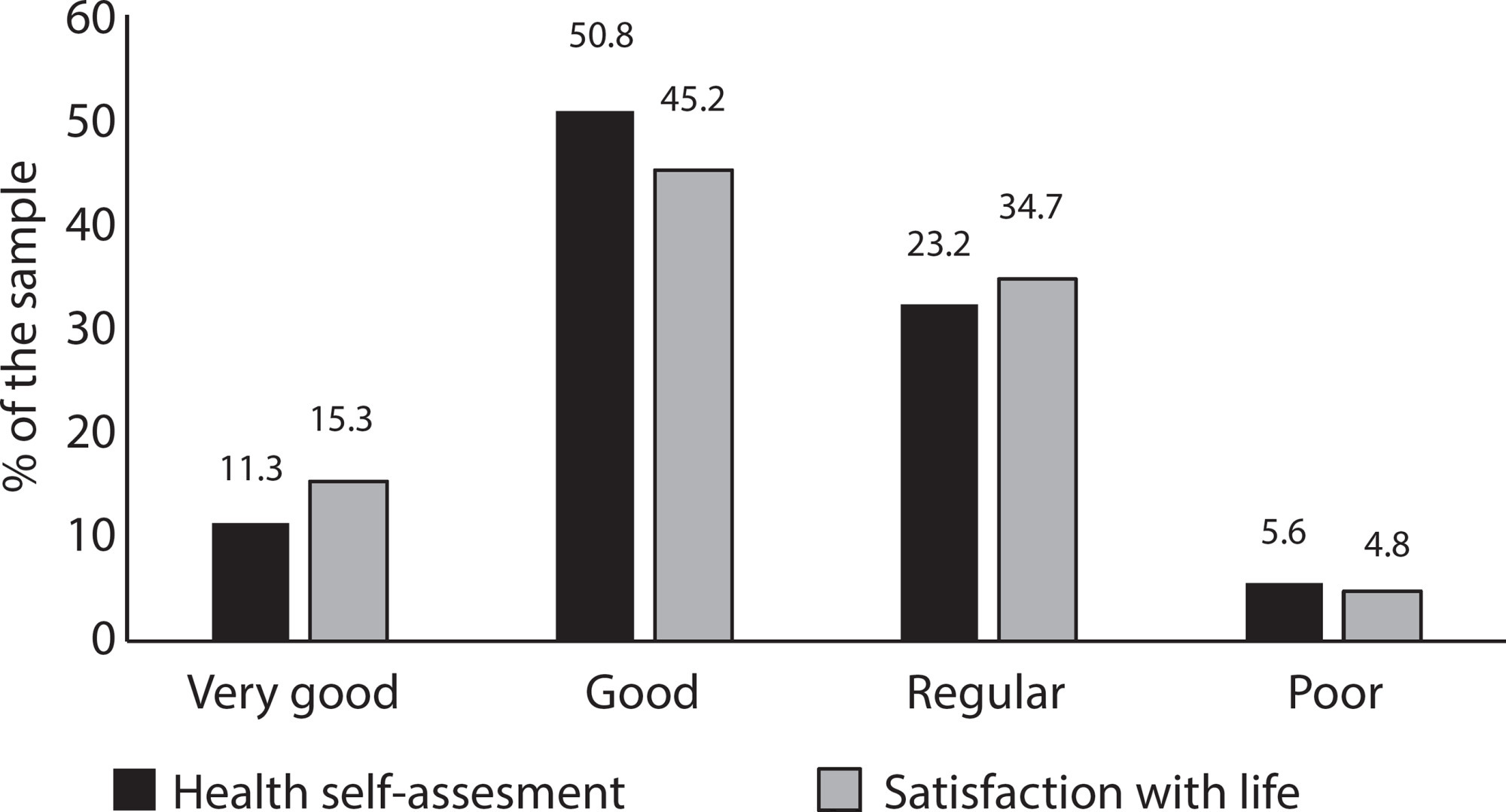
Search
Search in:
Nuvem de Tags
Adolescente (85) Atenção Primária à Saúde (239) COVID-19 (91) Criança (91) Cuidados de Enfermagem (269) Educação em Enfermagem (151) Educação em Saúde (139) Enfermagem (930) Enfermagem Pediátrica (86) Estudantes de Enfermagem (77) Estudos de Validação (131) Família (87) Idoso (208) Promoção da Saúde (99) Qualidade de Vida (104) Saúde do Trabalhador (86) Saúde Mental (145) Saúde Pública (82) Segurança do Paciente (150) Tecnologia Educacional (100)



